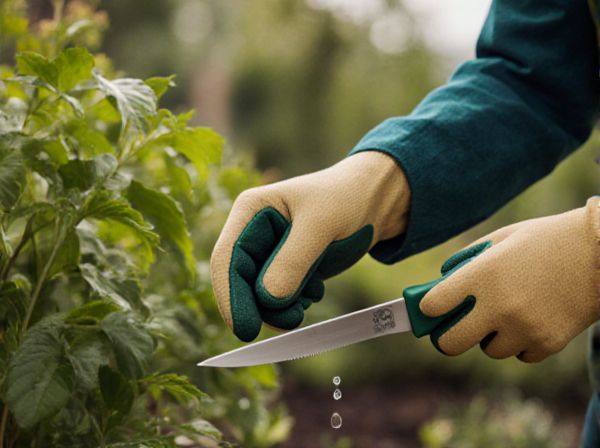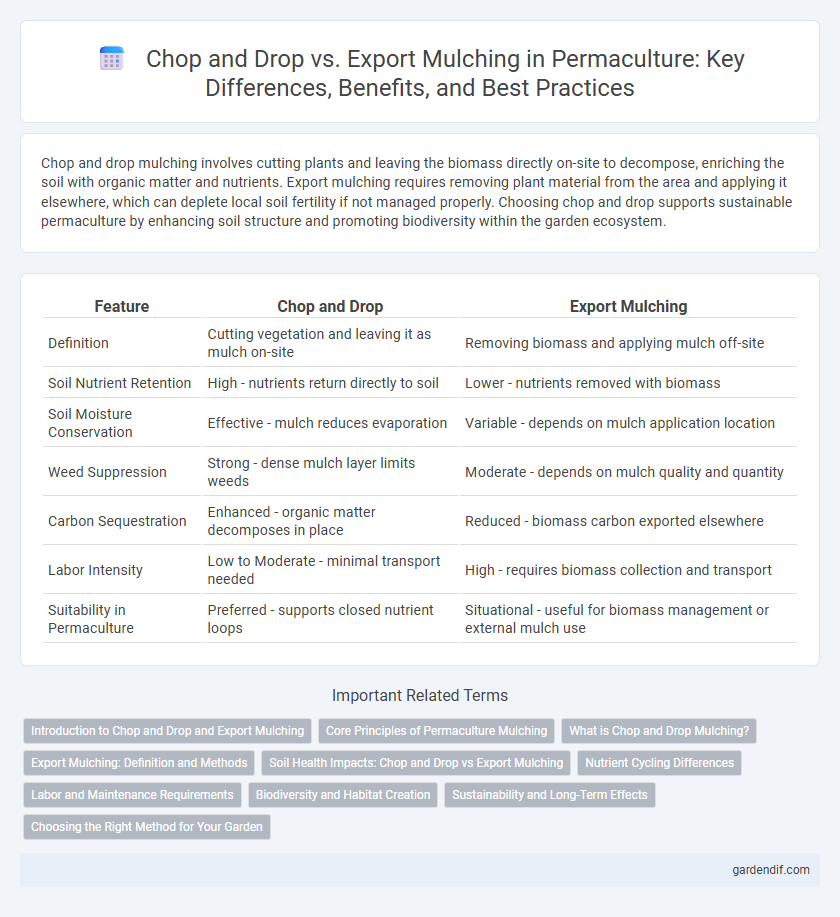
chop and drop vs export mulching Illustration
Chop and drop mulching involves cutting plants and leaving the biomass directly on-site to decompose, enriching the soil with organic matter and nutrients. Export mulching requires removing plant material from the area and applying it elsewhere, which can deplete local soil fertility if not managed properly. Choosing chop and drop supports sustainable permaculture by enhancing soil structure and promoting biodiversity within the garden ecosystem.
Table of Comparison
| Feature | Chop and Drop | Export Mulching |
|---|---|---|
| Definition | Cutting vegetation and leaving it as mulch on-site | Removing biomass and applying mulch off-site |
| Soil Nutrient Retention | High - nutrients return directly to soil | Lower - nutrients removed with biomass |
| Soil Moisture Conservation | Effective - mulch reduces evaporation | Variable - depends on mulch application location |
| Weed Suppression | Strong - dense mulch layer limits weeds | Moderate - depends on mulch quality and quantity |
| Carbon Sequestration | Enhanced - organic matter decomposes in place | Reduced - biomass carbon exported elsewhere |
| Labor Intensity | Low to Moderate - minimal transport needed | High - requires biomass collection and transport |
| Suitability in Permaculture | Preferred - supports closed nutrient loops | Situational - useful for biomass management or external mulch use |
Introduction to Chop and Drop and Export Mulching
Chop and drop mulching involves cutting plant materials and leaving them to decompose directly on the soil, enhancing organic matter and moisture retention in permaculture systems. Export mulching, on the other hand, consists of removing biomass from one area and applying it as mulch elsewhere, which redistributes nutrients and supports targeted soil fertility improvements. Both methods contribute to sustainable soil management but differ in nutrient cycling and labor intensity within permaculture practices.
Core Principles of Permaculture Mulching
Chop and drop mulching aligns with core permaculture principles by recycling organic matter directly into the soil, enhancing soil fertility and moisture retention while supporting local ecosystems. Export mulching, which involves removing biomass for off-site use, may reduce on-site nutrient cycling and soil structure benefits essential in permaculture design. Emphasizing nutrient retention, energy efficiency, and biodiversity, chop and drop enhances sustainable system resilience and long-term productivity.
What is Chop and Drop Mulching?
Chop and drop mulching is a permaculture technique where plant materials, such as pruned leaves and stems, are cut and left directly on the soil surface to decompose naturally. This process enriches the soil with organic matter, improves moisture retention, and promotes microbial activity without the need for external inputs. Unlike export mulching, which removes biomass from the site, chop and drop enhances onsite nutrient cycling and supports sustainable soil health.
Export Mulching: Definition and Methods
Export mulching in permaculture involves removing organic materials like pruned branches and plant residues from the site to reduce nutrient buildup and pest habitats. Common methods include hauling plant matter offsite for composting, using machinery to collect debris, and burning in controlled environments to manage excess biomass. This technique contrasts with chop and drop by actively exporting materials, promoting soil balance and minimizing disease risk.
Soil Health Impacts: Chop and Drop vs Export Mulching
Chop and drop mulching enhances soil health by returning nutrients and organic matter directly to the soil, promoting microbial activity and improving soil structure and moisture retention. Export mulching, while reducing nutrient recycling on-site, can lead to nutrient depletion and disrupt soil microbial communities if organic matter is consistently removed. Optimal soil health in permaculture systems is maintained by prioritizing chop and drop techniques to sustain soil fertility and biological diversity.
Nutrient Cycling Differences
Chop and drop mulching involves cutting plant material and leaving it on-site to decompose, enriching the soil with organic matter and micronutrients that promote nutrient cycling within the ecosystem. Export mulching removes biomass from the site, which can lead to nutrient depletion and a reliance on external inputs to maintain soil fertility. Nutrient cycling in chop and drop systems enhances soil microbial activity and nutrient retention, whereas export mulching disrupts these processes by extracting essential nutrients from the permaculture system.
Labor and Maintenance Requirements
Chop and drop mulching significantly reduces labor and maintenance by allowing plant matter to decompose naturally in place, minimizing the need for frequent soil disturbance and organic material transportation. Export mulching demands higher labor input for collecting, transporting, and spreading organic matter, increasing ongoing maintenance efforts to replenish mulch and manage soil health. Permaculture systems favor chop and drop techniques for their efficiency in conserving labor while sustaining soil fertility and structure.
Biodiversity and Habitat Creation
Chop and drop mulching enhances biodiversity by leaving organic matter on-site, which nourishes soil microorganisms and provides habitat for beneficial insects and small wildlife. Export mulching removes biomass, reducing habitat complexity and limiting food sources essential for pollinators and decomposers. Maintaining on-site mulch supports a diverse ecosystem, fostering natural pest control and improving overall habitat resilience in permaculture systems.
Sustainability and Long-Term Effects
Chop and drop mulching enhances soil fertility by returning organic matter and nutrients directly to the root zone, promoting natural nutrient cycling and reducing external inputs. This method increases moisture retention, supports beneficial microbial activity, and minimizes soil erosion, contributing to sustainable land management. In contrast, export mulching removes biomass from the system, potentially depleting soil nutrients over time and increasing dependence on artificial fertilizers, which can undermine long-term soil health and ecosystem resilience.
Choosing the Right Method for Your Garden
Chop and drop mulch enriches soil by decomposing organic matter directly on-site, enhancing microbial activity and retaining moisture. Export mulching involves removing plant debris to prevent pest buildup and disease, ideal for gardens prone to specific infestations. Selecting the right method depends on plant species, garden health, and local climate conditions to optimize nutrient cycling and plant growth.
chop and drop vs export mulching Infographic

 gardendif.com
gardendif.com